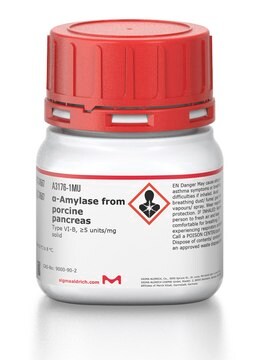P1625
Pancreatin aus Schweinepankreas
≥3 × USP specifications
Synonym(e):
Pancreatin aus Schweinepankreas
Anmeldenzur Ansicht organisationsspezifischer und vertraglich vereinbarter Preise
Alle Fotos(1)
About This Item
Empfohlene Produkte
Biologische Quelle
Porcine pancreas
Agentur
USP (specifications)
Form
powder
Spezifische Aktivität
≥3 × USP specifications
Lagertemp.
−20°C
Suchen Sie nach ähnlichen Produkten? Aufrufen Leitfaden zum Produktvergleich
Anwendung
Pancreatin from porcine pancreas is suitable:
- in a study to assess the treatment of steatorrhea by lipase supplementation therapy
- in a study to investigate treatment options for pancreatic diabetes in patients experiencing the decompensated stage of chronic pancreatitis
- to safely and effectively remove formalin-fixed tissues from arterial grafts without causing structural damage and loss in fiber integrity.
- to assess cleavage by digestive enzymes. It is used for in vitro digestibility analysis and to test the sensitivities of cellulolytic bacteria inhibitors
- along with amyloglucosidase for the in vitro digestion of starch in food samples
Biochem./physiol. Wirkung
Pankreatin enthält enzymatische Komponenten wie Trypsin, Amylase und Lipase sowie Ribonuklease und Protease, die von den exokrinen Zellen des Schweinepankreas erzeugt werden. Diese Enzymkombination ermöglicht das Hydrolisieren von Proteinen, Stärke und Fetten. Pankreatin konvertiert mindestens das 25-fache seines Eigengewichts an Kartoffelstärke innerhalb von 5 Minuten bei 40 °C warmen Wasser zu löslichen Kohlehydraten, verdaut mindestens das 25-fache seines Eigengewichts an Casein innerhalb von 60 Minuten bei einem pH-Wert von 7,5 und 40 °C, und setzt bei einem pH-Wert von 9,0 und 37 °C mindestens 2 Säure-Mikroäquivalente pro Minute pro mg Pankreatin aus Olivenöl frei.
Signalwort
Danger
H-Sätze
Gefahreneinstufungen
Eye Irrit. 2 - Resp. Sens. 1 - Skin Irrit. 2 - Skin Sens. 1 - STOT SE 3
Zielorgane
Respiratory system
Lagerklassenschlüssel
13 - Non Combustible Solids
WGK
WGK 1
Hier finden Sie alle aktuellen Versionen:
Besitzen Sie dieses Produkt bereits?
In der Dokumentenbibliothek finden Sie die Dokumentation zu den Produkten, die Sie kürzlich erworben haben.
Kunden haben sich ebenfalls angesehen
Ruixin Zhu et al.
Nutrients, 11(3) (2019-03-17)
Plant origin, processing, and domestic preparation may affect the postprandial glycemic response (PGR) of starchy foods. The objective of this study was to examine the possibility of integrating domestically cooked non-cereal starchy foods commonly consumed in Northeast Asia into glycemic
R Raghunathan et al.
Food chemistry, 221, 1514-1521 (2016-12-17)
The objective of this study was to determine the molecular structure and properties of recently released cultivars of field peas [CDC Golden (CDCG), Abarth (ABAR), CDC Patrick (CDCP) and CDC Amarillo (CDCA)] grown at different locations in Saskatchewan, Canada. Starch
Z Zhang et al.
Biomaterials, 16(5), 369-380 (1995-03-01)
Chemical, physical and structural analyses of polymers from explanted vascular prostheses are frequently jeopardized because of incomplete removal of the encroaching host tissue. In this study, microporous polyurethane arterial prostheses implanted as a canine thoraco-abdominal bypass were explanted after 1
Konstantinos Korompokis et al.
Food & function, 10(8), 4674-4684 (2019-07-12)
Wheat grain roller milling disrupts starch containing endosperm cell walls and extracts white flour. Many wheat based food processes involve simultaneous use of heat and water which then cause starch to gelatinize and enhance its digestibility. In this study, the
T Nakamura et al.
Pancreas, 16(3), 329-336 (1998-04-21)
Pancreatic steatorrhea and pancreatic diabetes are the dominant symptoms of patients in the decompensated stage of chronic pancreatitis (CP). In this stage, the nutritional state is greatly disturbed and hypoglycemia and labile infection are involved. Pancreatic enzyme replacement therapy is
Unser Team von Wissenschaftlern verfügt über Erfahrung in allen Forschungsbereichen einschließlich Life Science, Materialwissenschaften, chemischer Synthese, Chromatographie, Analytik und vielen mehr..
Setzen Sie sich mit dem technischen Dienst in Verbindung.










